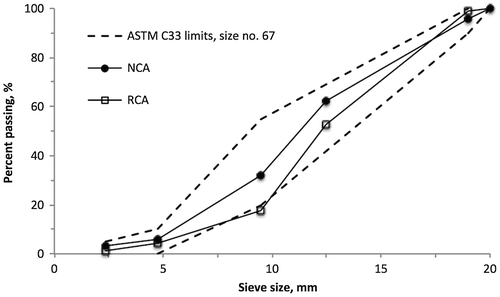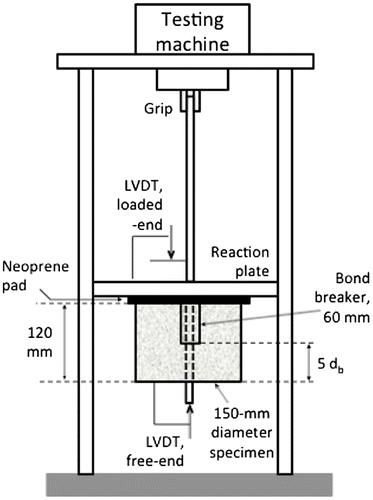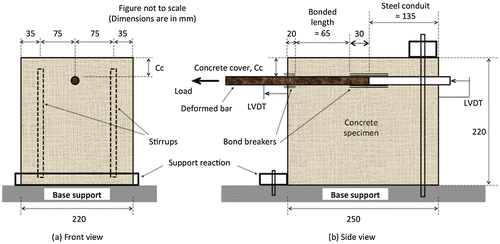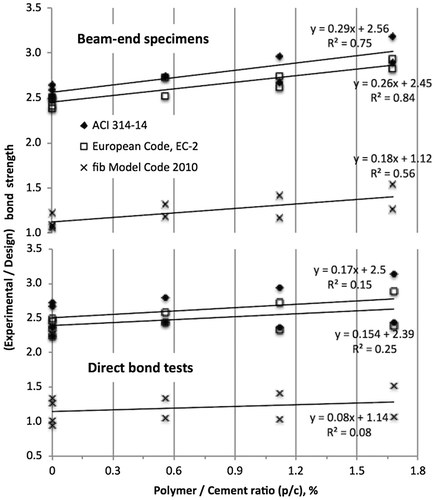Abstract
The use of recycled concrete aggregate (RCA) in structural applications is hindered by the inferior concrete mechanical performance and unpredictable behavior with embedded steel reinforcement. The main objective of this paper is to evaluate whether the addition of small amounts of styrene-butadiene rubber (SBR) polymeric latexes could mitigate the drop in RCA concrete properties. Two series of mixtures prepared with 320 or 440 kg/m3 cement were tested by direct bond and beam-end methods; the SBR addition rates varied from 1 to 3% of cement mass. Test results showed that SBR could remarkably improve RCA concrete workability as well as compressive and splitting tensile strengths. The initial stiffness of load vs. slip curves was considerably accentuated, reflecting increased interfacial shear stresses between the reinforcing bar and surrounding concrete. Also, the responses of ascending curves showed extended nonlinear regions together with higher ultimate bond strengths at failure. The experimental direct bond and beam-end test data are compared with the design bond strengths determined by ACI 318-14, European Code EC-2, and fib Model Code MC2010.
Introduction
Recycled concrete aggregate (RCA) obtained by processing construction and demolition waste acquired particular interest in civil engineering works. The use of RCA has the potential of supplementing current natural coarse aggregate (NCA) reserves, diverting demolition debris from landfills to promoting a sustainable construction approach.
Numerous studies have been carried out to evaluate the effect of partial or complete NCA replacement by RCA on fresh and hardened concrete properties, including the bond to reinforcing steel bars.[Citation1–3] Generally, it has been shown that RCA concrete properties are inferior from equivalent NCA mixtures, given the poorer quality of recycled aggregates including greater water absorption and lower density. In fact, RCAs are composed of NCA with approximately 30% of adhered mortar that gives a rough surface with numerous pores and micro-cracks.[Citation4] On the fresh state, concrete slump and its retention over time are often reduced, given the more angular shape and roughened texture of RCA that increases inter-particle friction.[Citation5,6] On the hardened state, RCA affects interfacial transition zone (ITZ) between aggregates and cement paste, which in its turn alters strength development. Reductions varying from 5 to 33% are reported for compressive strength and modulus of elasticity, while the splitting tensile strength remained the same or, at most, 15% lower.[Citation5,7,8]
For the bond behavior with embedded reinforcement, the majority of findings have shown that the various stages of load vs. slip curves for RCA concrete are fundamentally similar to NCA mixtures; yet, the ultimate bond strengths are remarkably scattered depending mostly on RCA quality and replacement rate. For instance, Xiao and Falkner [Citation9] reported that bond strength between recycled aggregate concrete and plain bars decreased by 12 and 6% for RCA replacement rates of 50 and 100%, respectively, while the bond remained almost similar with deformed steel. Fathifazl et al. [Citation10] investigated two types of RCA and reported similar findings to Xiao and Falkner. In contrast, Kim et al. [Citation11] reported that bond strength of RCA concrete decreases gradually when RCA replacement rate increased from 0 to 30, 60, and 100%; the highest drop was about 18% from equivalent NCA concrete. Butler et al. [Citation5] found that ultimate bond strength is directly affected by RCA quality; on average, RCA concrete developed around 10 to 21% lower bond strength than equivalent NCA mixture.
Context and paper objectives
It is clear that the widespread use of RCA in structural-grade reinforced concrete applications is hindered by the inferior mechanical properties as well as unpredictable behavior with embedded steel bars. Hence, to enhance RCA feasibility, different approaches have been proposed over the last years. For instance, Tam et al. [Citation12] adapted a two-stage process for concrete mixing; the first coats the RCA with rich cement slurry, while the second completes the addition of mixing water. The authors found that this technique could fill the ITZ micro-cracks and allow fresh paste to reach the surface of virgin aggregates. Kou et al. [Citation13] showed that the incorporation of 25 to 35% fly ash could help reduce some of the drawbacks induced by recycled aggregates, while Rao and Sireesha [Citation14] recommended combinations composed of 50% RCA with 8% silica fume in structural concrete. Tsujino et al. [Citation15] and Spaeth and Tegguer [Citation16] showed that RCA surface treatment with polymers such as silane, silicon, and paraffin oil would help reduce water absorption and degradation of aggregate mechanical properties. Fathifazl et al. [Citation17] found that reinforced RCA concrete beams can be conservatively designed using existing standards, provided that RCA is considered as a composite material that comprises mortar and natural aggregate.
Polymeric latexes are widely used in repair and patching works to increase adhesion and bond strengths of cementitious-based materials to various substrates. Latexes typically include styrene-butadiene rubber (SBR) and polyvinyl acrylic homo and copolymers; these consist of very small polymer particles (0.05–5 μm) formed by emulsion polymerization and stabilized in water with the aid of surfactants [Citation18]. In general, polymer-modified mortar and concrete show noticeable improvement in adhesion and tensile strengths with increased polymer-to-cement ratio (p/c), but limited increase in compressive strength when compared to unmodified systems.[Citation18–20] Gomes et al. [Citation21] reported three to fivefold increase in adhesion for polymer-modified cement pastes at 5 to 10% p/c on concrete substrates. The microstructural images of failure interfaces showed distinct diffusion of modified pastes to bonded substrate, implying the formation of monolithic bond between both materials.[Citation22] Latexes also found particular acceptance in reinforced concrete applications due to improved bond strengths with embedded steel as well as superior resistance to corrosion, chloride ion penetration, and oxygen diffusion [Citation18,23] The improved concrete–steel bond strength was attributed to electro-chemically active polymer–cement co-matrixes at the steel interfaces that help relax stresses during loading and retarding the friction-controlled slip of reinforcing bars.
Limited studies explored the possibility of incorporating polymeric latexes on performance of concrete containing RCA, including the extent to which such additions would mitigate the eventual drop in mechanical properties and bond strengths to steel bars. The paper is divided in three phases; the first seeks to evaluate the effect of SBR on plain concrete properties such as workability, air content, compressive/tensile strength, and modulus of elasticity. Two concrete mix designs prepared with 320 or 440 kg/m3 cement were tested; the NCA was 100% replaced by RCA, while SBR was added at 1 to 3% of cement mass. The second phase presents the effect of SBR on experimental bond stress vs. slip results determined by direct bond and beam-end methods, while the third phase compares the experimental data to design bond strengths specified in international codes including ACI 318-14, European Code EC-2, and fib Model Code MC2010. Data reported in this paper can be of interest to concrete engineers and technologists dealing with composite structures and efficient use of polymers to improve structural adhesive properties in the construction industry.
Experimental program
Coarse aggregate characterization
Continuously graded crushed limestone NCA having 20-mm nominal size was used in this study. The RCA was obtained by crushing returned concrete from ready-mixed batching plant; its nominal particle size was also 20 mm. The aggregates’ grading are shown in Figure , along with the upper and lower ASTM C33 limitations.[Citation24]
The physical NCA and RCA properties are summarized in Table . The freeze–thaw test procedure adapted by Abbas et al. [Citation25] was considered to determine the adhered mortar portion of RCA. The materials were immersed in sodium sulfate solution, and subjected to five daily cycles of freezing and thawing. After the final cycle, the sodium sulfate solution was drained and aggregates were washed and sieved over a 4.75-mm sieve. The aggregate crushing value (ACV), reflecting the compressive strength of loose aggregate, was determined by subjecting a measured volume of aggregate to 400-kN load.[Citation26] After crushing, the sample is sieved over 2.36-mm sieve where the percentage of material passing the sieve represents the ACV (i.e. higher ACV value reflects weaker aggregates with lower compressive strength). The specific gravity, water absorption, and density were determined as per ASTM C127[Citation27]; while materials finer than 75-μm as per ASTM C117.[Citation28] The fineness modulus reflects the mean size of particles present in the entire body of aggregate; it is determined as per ASTM C33.[Citation24]
Table 1. Physical properties of NCA and RCA used for concrete batching.
Materials used for concrete production and bond testing
Portland cement conforming to ASTM C150 Type I was used; its surface area, median particle size, and specific gravity were 355 m2/kg, 24.7 μm, and 3.14, respectively. The natural fine aggregate consisted of well-graded siliceous sand complying to ASTM C33 specification[Citation24]; its bulk specific gravity, fineness modulus, and absorption rate were 2.65, 2.5, and 0.97%, respectively. A naphthalene-based high-range water-reducing (HRWR) admixture with specific gravity of 1.18 and solid content of 34% was used. This admixture complies with ASTM C494 Type F; it can be used up to 3.5% of cement mass.
Commercially available SBR typically used for enhancing flexibility and water impermeability of cementitious materials was used. The carboxylated styrene-butadiene dispersion contains 60% of bound styrene without solvents and stabilized using anionic emulsifying system. Its solid content, specific gravity, pH, Brookfield viscosity (spindle 4 at 10 rpm), maximum particle size, and minimum film forming temperature are 56%, 1.05, 8.5, 250 cP, 0.22 μm, and −5 °C, respectively. Relevant research studies examining the effect of SBR latexes on fresh and hardened properties of cementitious materials can be seen in references 18, 19, 20, and 29.
Deformed steel bars were used to evaluate bond stress–slip behavior of reinforcement embedded in NCA concrete as well as RCA concrete prepared with or without SBR. The steel bars complied to ASTM A615 No. 13 with nominal diameter (db) of 12.7 mm; the Young’s modulus and yield strength (fy) were 203 GPa and 428 MPa, respectively. The bar’s bond index (or relative rib area ratio) was equal to 0.047; this index is calculated as (de2 – di2)/(4 db S), where de is the external bar diameter (top of rib) equal to 13 mm, di is core diameter (bottom of rib) equal to 12.2 mm, and S is longitudinal spacing of the ribs equal to 8.5 mm.[Citation29]
Concrete proportioning and mixing
Two control NCA concrete mixtures (i.e. lean and high strength) commonly used for residential and repair applications were considered. The lean mix contained 320 kg/m3 cement with 0.56 water-to-cement ratio (w/c), while the high-strength one was made using 440 kg/m3 cement and 0.44 w/c (Table ); the corresponding 28-day f′c was 31.6 and 54.8 MPa, respectively. The HRWR dosage was adjusted at either 0.85 or 1.45%, respectively, of cement mass to achieve slump of 220 ± 10 mm. The sand-to-total aggregate ratio was set at 0.46.
Table 2. Concrete proportions using different aggregate types and SBR additions.
The effect of recycled aggregates on fresh and hardened concrete properties was evaluated by 100% replacement of natural aggregate by RCA, with or without SBR addition. The cement content, net w/c (given that water content in SBR was accounted during concrete batching), HRWR dosage, and sand-to-total aggregate ratio remained fixed as described earlier for control NCA mixtures. As can be seen in Table , three SBR dosage rates of 1, 2, and 3% of cement mass (i.e. p/c of 0.56, 1.12, and 1.68%, respectively) were added in RCA mixtures. It is to be noted that SBR polymers could be used up to 10% of cement content during concrete production[Citation18,22,30]; however, this was limited to 3% in this study because of the tangible improvement in RCA concrete performance when compared to equivalent NCA mixtures. Also, practically speaking, it is generally desirable to limit polymer addition rates to prevent excessive increase in concrete cost.
Given the high RCA water absorption and eventual effect on concrete workability, all coarse aggregates (i.e. RCA and NCA) were pre-soaked for 24 h in water and then drained prior to batching to ensure full saturation at or above saturated surface dry condition.[Citation1,5,13] The batch proportions were adjusted for aggregate surface moisture to maintain constant w/c. All mixtures were prepared in open-pan mixer of 100-Liter capacity. The mixing sequence consisted of homogenizing the sand, aggregate, and around 50% of mixing water before introducing the cement. After one minute of mixing, the other 45% of water was added, followed by HRWR, and then SBR diluted in the remaining 5% of water. The concrete was mixed for two additional minutes. The ambient temperature during mixing and sampling hovered around 21 ± 3 °C.
Specimen preparation and experimental testing
Following the end of mixing, the slump and air contents were determined as per ASTM C143 and C231 Test Methods, respectively. The fresh concrete was then filled in 100 × 200-mm steel cylinders to determine the compressive strength (f′c), splitting tensile strength (ft), and static modulus of elasticity (E) as per ASTM C39, C496, and C469 Test Methods, respectively.[Citation31–33] The procedure for compacting the concrete in cylinders, demolding after 24 h, curing in water, capping, and testing at 28 days were according to ASTM C192 Practice. Prior crushing, the unit weight was determined by dividing the mass of concrete samples by the corresponding volume. Averages of three measurements are considered in this paper; the failure planes of concrete cylinders were examined visually after crushing using a magnifying glass and classified as being mainly around or mainly through the aggregate skeleton.[Citation5,34]
The bond stress–slip behavior for each concrete mixture was tested using two fundamentally different methods, i.e. direct bond and beam-end specimen. The former test is simple, however, and does not represent realistic conditions since the concrete around the loaded bar is under compression and the cover is quite large.[Citation29,35] In contrast, the beam-end test is cumbersome, yet simulates more practical conditions including realistic concrete cover and a bar that is pulled out from concrete placed under tension.[Citation5,35,36] The descriptive details of both methods are given below.
Direct bond test
The direct bond specimens were cast in 150-mm-diameter cylinders having 120-mm height (Figure ). The bars were placed vertically in the bottom of molds before casting; the embedded length was 60 mm (5 db) and PVC bond breaker with a length of 60 mm (5 db) was inserted around the rebar at concrete surface, in accordance with RILEM/CEB/FIB recommendations.[Citation37] The steel bars were cleaned prior to use, and highly elastic silicon material was placed between the rebar and PVC tube.
The concrete was compacted in the molds in a similar manner than the cylinders used for compression, demolded after 24 h, covered with plastic bags, and allowed to cure at 23 °C for 28 days. The pullout test was performed using a universal testing machine by recording the pullout load of the steel bar at one end with the concrete block being encased in the steel reaction frame. The rebar’s relative slips to concrete were monitored from measurements of two LVDTs placed at the free and loaded ends of the specimen. To minimize eccentricity effects and tangential stresses, neoprene pads were placed between the concrete top surface and reaction frame.
Beam-end test
The beam-end specimen dimensions followed the general guidelines of ASTM A944[Citation38]; the specimens measured 220 mm in width, 250 mm in length, and 220 mm in height. The side and front views of specimen are shown in Figure . The bar enters the beam-end specimen at the loaded end, extends into the specimen along a short un-bonded length, extends further along a bonded length, and has additional un-bonded length before terminating within a hollow steel conduit to provide access to the free end for measuring slip. The specimen is positioned in a test rig so that the bar can be pulled slowly from concrete. During loading, the specimen is restrained from translation through a compression reaction plate and restrained from rotation through a tie-down, thus approximating boundary conditions of simply supported beams.[Citation5,36]
All steel bars were embedded inside the specimens at fixed lengths of 65 mm. The concrete clear cover was kept constant at 40 mm, a size typically used in the design of beams. Tolerances for bonded lengths, clear covers, and overall specimen dimensions were ±2, 3, and 5 mm, respectively. Two stirrups placed on each side were provided for shear resistance, but were oriented parallel to the ‘pull’ direction to avoid confining the test bar along its bonded length. The closed stirrups were made of No. 10 plain bars (ASTM A615) with nominal diameter of 9.5 mm.
The concrete samples were placed in two consecutive lifts in the beam-end specimen molds, and internally vibrated using 150-Hz frequency vibrator. Care was taken in the insertion of the vibrator to avoid formation of air bubbles around the steel bars. The specimens were demolded after 24 h, covered with plastic bags, and allowed to cure at 23 °C for 28 days. Before testing, the specimen was aligned so that the test bar is parallel to the loading frame. The tensile load was gradually applied at a rate of 25 ± 4 kN per minute until bond failure occurred. The bar’s relative slips to concrete were monitored from measurements of two LVDTs placed at the free and loaded bar surfaces (Figure ).
Test results and discussion
Phase I – Effect of RCA and SBR additions on fresh and hardened concrete properties
Repeatability of responses
Table summarizes the fresh and hardened properties of tested concrete, along with coefficients of variation (COVs) determined for selected mixtures to evaluate repeatability of responses. The COVs are determined as the ratio between standard deviation of three responses obtained from different batches divided by mean value, multiplied by 100. As can be seen, the variations in slump, air content, f′c, ft, and E were quite limited for concrete prepared using RCA without or with 1% SBR; the resulting COV was less than 3.9, 6.1, 4.7, 5.2, and 7%, respectively. The COVs increased to 5.2, 7.3, 7.7, 9, and 8.5%, respectively, for RCA concrete containing 3% SBR. This can naturally be due to increased interactions taking place between the polymer particles and cement hydrating compounds.
Table 3. Effect of RCA and SBR additions on fresh and hardened concrete properties.
Air content and workability
Generally, the air content of fresh concrete prepared with RCA did not vary considerably with respect to the corresponding NCA mixture (Table ). Nevertheless, this followed an increasing trend with SBR additions; for example, such increase was from 2.7% for 440-RCA mix prepared without polymer to 3.2 and 3.7% when the SBR was added at 1 and 3% rates, respectively. This could be related to the surfactant agents added to stabilize the SBR polymers including their inherent surface activity (i.e. ability to reduce surface tension of water) and solubility in the high cement pH solution.[Citation39,40]
As expected, the use of RCA led to reduced workability when compared to equivalent NCA mixture. For example, such reduction reached 155 and 160 mm for RCA concrete prepared with 320 or 440 kg/m3 cement, respectively (Figure ). This can mostly be attributed to the angular and roughened surface texture of recycled aggregates that increased internal friction in fresh concrete [Citation1,5,7] (note that pre-soaking should have eliminated any slump loss due to RCA absorption of mixing water). Nevertheless, the incorporation of increased polymer additions led to improved workability, which can be related to the ball-bearing and plasticizing effects resulting from the polymer spherical shapes.[Citation20,30] For example, the slump increased from 160 mm for 440-RCA concrete to 185 and 205 mm with 2 and 3% SBR additions, respectively (Figure ). Additionally, the improvement in flow can partly be attributed to increased amounts of air entrainment in the polymer-modified concrete.
Hardened properties including f′c, ft, and E
The variations in hardened properties (i.e. Δ(Property)) of RCA concrete prepared with or without SBR are plotted in Figure . Each Δ(Property) was normalized with respect to the corresponding control NCA concrete made with either 320 or 440 kg/m3 cement, as follows:
Figure 5. Effect of RCA and SBR additions on variations in hardened concrete f′c, ft, and E properties.
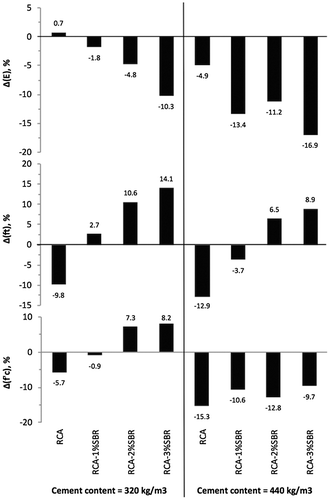
Compressive strength
Concrete made without polymers
As can be seen in Figure , the complete NCA substitution by RCA led to reduced f′c, particularly for high-strength mixtures prepared with 440 kg/m3 cement. Hence, Δ(f′c) varied from −5.7 to −15.3% for concrete made with 320 or 440 kg/m3 cement, respectively. Several authors associated the f′c drop in lean and high-strength RCA concretes to different fracture patterns that strongly depend on relative strength of new vs. old mortar including crack propagation through the new vs. old ITZ during loading[Citation5,8,41]. In the case of this study, the visual examination of crushed concrete cylinders made with 320 kg/m3 cement showed distinct failure planes occurring mainly around the aggregate particles, suggesting that the ITZ between the mortar–aggregate (whether NCA or RCA) is the limiting strength factor. In contrast, the failure planes become less distinct and mostly pass through the aggregate particles for concrete prepared with 440 kg/m3, implying that the aggregate strength itself is the limiting factor.
Effect of SBR on Δ(f′c)
Clearly, the use of increased SBR concentration improved f′c of RCA mixtures, albeit this varied depending on cement content and strength of the original concrete (Figure ). For example, Δ(f′c) increased significantly from −5.7% for lean 320-RCA concrete made without SBR to +7.3 and +8.2% for equivalent mixtures containing 2 or 3% SBR, respectively. This can be attributed to the polymer particles that strengthen the mortar–aggregate interface, especially knowing that f′c of lean concrete mixtures is mostly governed by the ITZ behavior. In contrast, the Δ(f′c) increase in high-strength concrete prepared with 440 kg/m3 cement was much less pronounced. Hence, Δ(f′c) varied from −15.3% for 440-RCA concrete made without SBR to only −9.7% for the mix containing 3% SBR. This practically suggests that the beneficial polymer effect on f′c of recycled aggregate concrete is directly affected by the mixture proportioning.
Splitting tensile strength
Unlike Δ(f′c), the Δ(ft) was not remarkably affected the mixture composition; this varied from −9.8 to −12.9% for RCA concrete prepared with 320 or 440 kg/m3 cement, respectively. The incorporation of SBR led to gradually increased ft values, even higher than corresponding NCA concretes. For example, Δ(ft) reached +14.1 and +8.9% for RCA mixtures made with 320 or 440 kg/m3 cement, respectively, containing 3% SBR. In fact, it is well accepted that the structure of hardened cement paste is mainly composed of agglomerated calcium silicate hydrates and calcium hydroxide bound together by weak van der Waals forces, whereby micro-cracks could occur easily under stress leading to poor tensile strength.[Citation18,30] Hence, in latex-modified systems, the micro-cracks are bridged by the polymer films that prevent crack propagation in hardened ITZ, resulting in stronger cement hydrate–aggregate bond. Concurrently, the improved smoothness and flowability of modified RCA concrete are expected to reduce porosity of ITZ and develop increased bond by micro-mechanical interlocking mechanisms.[Citation20,21]
Modulus of elasticity
The modulus of elasticity for RCA concrete prepared with 320 kg/m3 cement remained almost unchanged when compared to NCA concrete, and decreased to −4.9% for higher strength concrete made with 440 kg/m3 cement (Figure ). The Δ(E) gradually reduced with increased SBR additions, which could be attributed to the latex polymer films that provide improved deformation and elasticity through their high tensile strengths.[Citation18,19]
It is interesting to note that the decrease in E was almost similar for given SBR addition rates, regardless of concrete composition. For example, such decrease reached −10.3% for RCA concrete made with 320 kg/m3 cement and 3% SBR (thus making a difference of 11% when compared to concrete made without SBR, i.e. from +0.7 to −10.3%). In the case of RCA concrete prepared with 440 kg/m3 cement, Δ(E) reached −16.9 at 3% SBR (thus making a difference of 12%, i.e. from −4.9 to −16.9%). Such results are in agreement with other findings generated using virgin aggregate concrete,[Citation18,30] implying that variations in modulus of elasticity are much more influenced by SBR additions than the type of aggregates (i.e. whether NCA or RCA) used for concrete production.
Relationships between p/c and Δ(Property)
The relationships between p/c and Δ(Property) determined for lean and high-strength mixtures are plotted in Figure . Clearly, f′c and ft followed increasing trends with p/c, albeit the rate of such increase depended on the cement content. For instance, Δ(f′c) remained within the negative region for higher strength RCA concrete made with 440 kg/m3 cement. In contrast, the threshold p/c hovered around 0.6% for f′c determined on lean mixtures prepared with 320 kg/m3 cement as well as for ft obtained from either lean or high-strength mixtures. Below this threshold, f′c and ft are less than the corresponding NCA concrete, while above it, the RCA concrete exhibits better strength performance. This practically implies that polymeric latexes can be effectively used to compensate the loss in RCA concrete strengths, particularly when the ITZ between the mortar–aggregate is the limiting strength factor. On the other hand, it is to be noted that Δ(ft) increase is around twofold higher than the corresponding Δ(f′c) for given p/c, suggesting that the former property is much more influenced by polymers than the compressive strength.
Figure 6. Relationships between p/c and variations in hardened properties for concrete prepared with 320 or 440 kg/m3 cement.
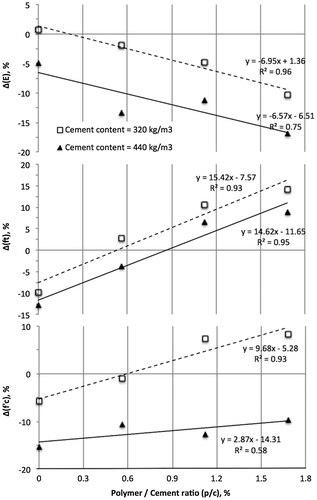
Irrespective of cement content, the Δ(E) values followed decreasing trends toward the negative region with p/c. At the threshold p/c of 0.6%, Δ(E) hovered around 0% for concrete prepared with 320 kg/m3 cement, while this was around −10% for high-strength mixtures made with 440 kg/m3 cement. The improved elasticity due to SBR in RCA concrete reflects higher ductility, which could be of interest for higher strength concrete where splitting failure most likely occurs suddenly.[Citation35]
Phase II – Effect of RCA and SBR additions on bond stress–slip behavior
Table summarizes the bond stress–slip characteristics of the tested concrete including the bond stresses corresponding to slip of 0.01 and 0.1 mm (τ0.01 mm and τ0.1 mm, respectively), ultimate bond stress (τu) representing the maximum load at failure, and slip at free-end (δu) coinciding with the ultimate load. It is to be noted that τ was assumed to be uniformly distributed along the bar’s embedded surface[Citation29,35,36]; it is given as τ = P / π db L, where P and L refer to the load applied and embedded length, respectively. Also, the normalized bond stress calculated as the ratio of τu for each testing method to the square root of f′c is given in Table .
Table 4. Effect of SBR on bond stress–slip concrete properties determined by direct bond and beam-end tests.
Repeatability of responses
As expected, the COVs for bond were larger than those obtained for plain concrete properties (f′c, ft, and E), given the coupled dependency of bond results on variations in hardened properties and implemented procedures such as compaction, bar orientation, and curing. Hence, the COV reached 17, 14.8, 18.3, and 21.3% for τ0.01 mm, τ0.1 mm, τu, and δu responses, respectively, determined by direct bond. Such COVs reached 22.3, 19.4, 19.2, and 20%, respectively, when using beam-end specimens. It is to be noted that all tests exhibited pullout modes of failure characterized by crushing and shearing of the localized embedded region around the bar. No cracks were observed on their external surfaces, indicating that the concrete cover provided adequate confinement.[Citation29]
Bond stress vs. slip curves of tested mixtures
The τ vs. δ curves determined using direct bond and beam-end tests for control NCA concrete prepared with 320 kg/m3 cement as well as those made using RCA with or without SBR additions are given in Figure .
Figure 7. Typical τ vs. δ curves determined by direct bond and beam-end tests for NCA concrete as well as RCA concrete modified with various SBR concentrations.
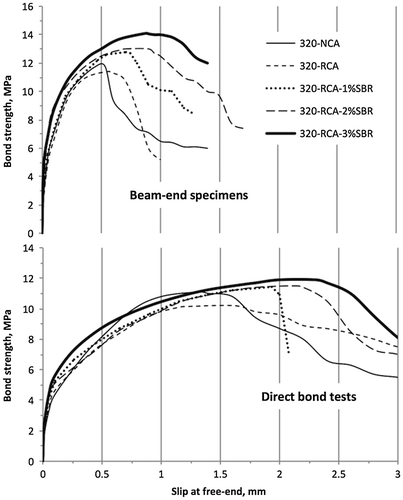
Behavior of control NCA concrete
Generally, the bond between steel and concrete consists of three mechanisms including adhesion, mechanical interlock, and friction.[Citation10,11,42,43] The initial stiffness in the local τ vs. δ relationship is attributed to the adhesive component of bond, and mechanical interlock does not develop until adhesion fails and relative displacement between bar and concrete occurs. The force transfer is thus achieved by bearing of the bar ribs on surrounding concrete, causing the formation of internal cracks and nonlinearity of ascending τ vs. δ curves. As shown in Figure , the slips in the elastic and nonlinear regions that resulted from beam-end tests are considerably lower than those of direct bond, which can be explained by the primary nature of each test.[Citation35] For instance, at the very small slip of 0.01 mm, τ0.01 mm of control 320-NCA mixtures increased from 1.66 to 2.54 MPa when tests are realized by direct bond or beam-end specimens, respectively. The corresponding τ0.1 mm increased from 4.36 to 7.13 MPa, respectively.
The mechanical interlock continues until reaching τu, whereby excessive local slip occurs and concrete between bar deformations shears off. Concurrent with other findings,[Citation35] the magnitude of τu for control mixtures was not remarkably affected by testing method (i.e. 11.1 and 11.8 MPa for direct bond and beam-end, respectively, for 320-NCA concrete). In the post-peak region, only the frictional component of bond remains, and the bond transferred along the bar–concrete interface reduces as the local slip increases. The corresponding slip at τu determined by beam-end was 0.53 mm, yet increased to 1.32 mm during direct bond.
Behavior of RCA concrete made without SBR
Concurrent with existing literature,[Citation5,9–11] the complete substitution of NCA by RCA did not result in considerable changes in τ vs. δ curves. Hence, the three mechanisms described earlier can be identified in Figure , implying that bond development and deterioration between RCA concrete and deformed steel bars are fundamentally similar to those observed in NCA concrete.
Nevertheless, the τu at failure for RCA concrete was relatively lower than the equivalent value determined using NCA mixture, especially for higher strength concrete prepared with 440 kg/m3 cement. For example, τu of 440-NCA mixture decreased from 16.8 to 15.2 MPa during direct bond, and from 16.3 to 14.7 MPa for beam-end specimens (Table ). This can be directly attributed to the reduced RCA concrete hardened properties including f′c and ft, thus reducing the material’s bearing strength capacity in front of the bar ribs.[Citation42,43]
Behavior of RCA concrete containing SBR
Regardless of the testing method, the bars’ free-end of polymer-modified RCA concrete started to slip at bond stresses higher than those of control mixtures, thus accentuating the initial stiffness of τ vs. δ curves (Figure ). For example, at the very small slip of 0.01 mm, τ0.01 mm increased from 1.8 MPa for 320-RCA concrete prepared without SBR and tested by direct bond to 2.06 and 2.3 MPa with the addition of 2 or 3% SBR, respectively (Table ). In beam-end tests, such increase was from 2.3 to 3.05 and 4.6 MPa, respectively. This can be directly attributed to the latex polymers that increase the adhesive component in the elastic region and result in increased interfacial shear stresses between the reinforcing bar and surrounding concrete. Ohama [Citation18] related this phenomenon to the presence of electro-chemically active polymer–cement co-matrixes at the interfaces with reinforcing bars, thus relaxing the stresses during loading and retarding the friction-controlled slip of rebars.
When the adhesive component of bond fails, the responses of ascending curves of SBR-modified concrete showed extended nonlinear regions, which can be explained by more pronounced compressive strain-softening phenomenon due to the presence of polymer latexes.[Citation42] For example, δu during direct bond increased from 1.62 mm for 320-RCA concrete prepared without SBR to 2.1 mm with 2% SBR addition, while this varied from 0.55 to 0.9 mm for beam-end specimens (Table ).
It is interesting to note that the rate of τu increase due to SBR additions was affected by the testing method. For example, during direct bond, τu reached 11.5 and 11.9 MPa for 320-RCA concrete prepared with 2 or 3% SBR (i.e. Δ(τu) of 3.6 and 7.2%, respectively), while such increase was more significant in beam-end specimens as it reached 13 to 14.1 MPa (i.e. Δ(τu) of 10.2 and 19.5%, respectively). This can be explained by the nature of each test during which the bond to steel is affected by the plain properties of the surrounding concrete. Hence, during direct bond, concrete is placed in compression and SBR additions have shown limited increases in f′c, as discussed earlier in Figure . In contrast, the bond resistance in beam-end specimen is achieved by circumferential tension stresses created in the concrete around the bar; if these forces exceed the tensile concrete capacity, failure occurs.[Citation36, 42] Therefore, given that ft of RCA concrete is significantly improved with polymer additions, this can reduce the propagation of micro-cracks and result in increased bond resistance with reinforcing bar.
Relationships between p/c and bond properties
The relationships between p/c and variations in τ0.01 mm, τu, and δu properties during direct bond and beam-end testing are plotted in Figure . Regardless of the testing method, RCA concrete incorporating higher SBR additions (i.e. higher p/c) led to increased Δ(τ0.01 mm), suggesting that the adhesive component of bond could be significantly improved with added polymers. The threshold p/c beyond which Δ(τ0.01 mm) exceeds the equivalent NCA concrete is around 0.3%, while such improvement could be as high as 90% at 1.68% p/c.
Figure 8. Effect of p/c on variations in τ0.01, τu, and δu properties determined by direct bond and beam-end testing.
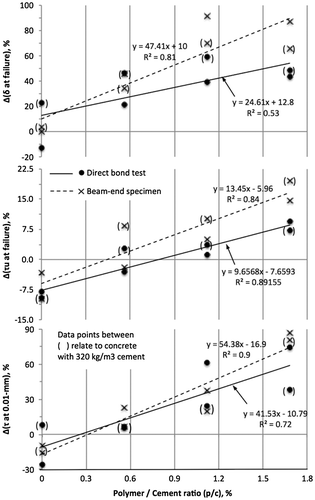
Tests realized by direct bond showed relatively limited increase in Δ(τu), when compared to equivalent beam-end specimens at similar p/c. For example, Δ(τu) determined by direct bond reached 7.2% for concrete made with 320 kg/m3 cement with 1.68% p/c, while this increased to 19.5% using beam-end specimen. As already noted, this can be attributed to the nature of each test and variations in hardened concrete properties due to SBR (i.e. Δ(f′c) and Δ(ft) equal to 8.2 and 14.1%, respectively) that affect the ultimate bond strength. It is to be noted that the threshold p/c beyond which Δ(τu) exceeds equivalent NCA mixture is around 0.4% and 0.8% during beam-end and direct bond testing, respectively. The relationships between p/c and normalized τu ratio determined by both methods are illustrated in Figure . As can be seen, the relationships followed an increasing trend with p/c, albeit such trend was more accentuated with beam-end specimens with higher R2 of 0.86.
Figure 9. Relationships between p/c and normalized bond stress (i.e. τu / (f′c)^0.5) determined by direct bond and beam-end testing.
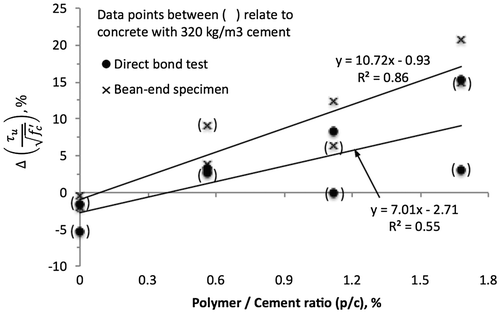
The slips at failure shifted gradually toward higher values with increased p/c (Figure ); the resulting R2 was 0.81 and 0.53 for beam-end and direct bond, respectively. At the highest p/c of 1.68%, Δ(δu) reached 88 and 48% during beam-end and direct bond testing, respectively. Practically, this indicates that the structural ductility of reinforced RCA concrete members tends to increase with SBR additions.
Prediction of bond stresses in polymer-modified RCA concrete
As can be seen in Figure , Δ(ft) can be considered a good indicator for predicting the variations in RCA concrete bond to steel due to SBR additions, whether determined by direct bond or beam-end specimen. Hence, higher Δ(ft) is associated with higher increases in τ0.01 mm, τ0.1 mm, and τu values. The resulting R2 was relatively moderate for τ0.01 mm values, but then gradually increased for τ0.1 mm and τu; for example, this varied from 0.65 to 0.76 and 0.9, respectively, for beam-end specimens. It is important to note that weak correlations with extremely low R2 values were found between Δ(f′c) and variations in bond stresses. This can be related to the intrinsic polymer mode of action that marginally affects compressive strength, yet with significant increase in tensile strength as a result of monolithic bond formation between cement paste and RCA particles.
Figure 10. Relationships between tensile strength variations due to SBR additions and bond strength determined by direct bond and beam-end testing.

Phase III – Comparison with specified code design equations
The experimental τu values measured by direct bond and beam-end tests are compared with the design bond strength (fb) specified in ACI 318–14,[Citation44] European Code EC-2,[Citation45] and fib Model Code MC2010.[Citation46]
In ACI 318-14, the fb is derived for ultimate state conditions as (fy/4)/(Ld/db), where Ld is the bar development length. After replacement in ACI Equation (12.1),[Citation44] fb becomes:(1)
where Cb is the distance from bar center to the nearest concrete surface and Ktr the transverse reinforcement factor (note that the code limits the ratio of (Cb + Ktr)/db to 2.5). The Ψt, Ψe, Ψs, and λ refer to bar location, epoxy coating, bar size, and lightweight concrete factors, respectively. In this study, (Cb + Ktr)/db is set to 2.5, given that Ktr equals to 0 and Cb for direct bond and beam-end tests is equal to 75 and 46 mm, respectively. The Ψs is taken as 0.8 for bars No. 13, while Ψt, Ψe, and λ equal to one.
The EC-2 [Citation45] specifies the following expression for determining the ultimate bond stress:(2)
where η1 is a coefficient related to the quality of bond condition and bar positioning during concrete and η2 is related to bar diameter. In this study, both coefficients are equal to one (i.e. considering good bond conditions and actual db is less than 32 mm). The fctd refers to concrete design tensile strength defined as αct fctk,0.05 / γc, where αct is a coefficient taking into account the long-term effects on tensile strength (taken equal to one), γc partial safety factor (also, taken as one), and fctk,0.05 is the concrete characteristic axial tensile strength calculated as 0.7 × 0.3 × fck(2/3) for fck less than 50 MPa. The fck is the compressive concrete cylinder strength at 28 days.
Finally, fib MC2010 [Citation46] proposes using the following semi-empirical equation (Equation 6.1–19) for monotonic loading of short anchorage lengths in good bond conditions:(3)
where fcm is the concrete cylinder compressive strength, lb bond length of anchored bar (taken equal to 5db = 5 × 12.7 = 63.5 mm), and km × Ktr refers to the confinement reinforcement ratio (taken equal to 0). The cmin and cmax refer to minimum and maximum concrete covers, respectively, complying with the following limitations: 0.5 < cmin/db < 3.5 and 1 < cmax/cmin < 5. In this study, cmin/db is taken as 3.5 for direct bond and beam-end specimens, while cmin is taken equal to cmax.
Table summarizes the design fb determined following Equations (1–3). The experimental-to-design bond strength ratios (EDR) determined by direct bond and beam-end tests using NCA and RCA mixtures are plotted in Figure as a function of p/c. Clearly, ACI 318-14 and EC-2 equations underestimate the actual τu generated along the anchored bar length[Citation35]; this resulted in EDR varying from 2.5 to 3.2. The R2 values that resulted from beam-end specimens are remarkably higher than those obtained from direct bond, given the increased influence of polymer additions on tensile strength development.
Table 5. Design bond strengths, in MPa, determined as per ACI 318-14, EC-2, and fib MC2010 equations.
The EDR becomes pretty close to one when the fib MC2010 equation is used, implying improved appropriateness to reflect current τu values. The EDR calculated from beam-end specimens followed an increasing trend with p/c with moderate R2 of 0.56, which can be explained by the increase in τu with increased p/c (while corresponding fb calculated from Equation (3) remained almost stable). This reflects the improvement in bond behavior that SBR-modified RCA concrete can confer to the tension bars, as compared to fb specified by the fib MC2010 equation.
Summary and conclusions
The use of RCA in structural-grade concrete is often hindered by the concerns related to the inferior concrete mechanical properties and unpredictable behavior with embedded steel bars. The main objective of this paper is to evaluate whether the addition of small amounts of SBR polymers would alleviate such concerns. Based on foregoing, test results have shown that the incorporation of SBR can remarkably improve RCA concrete workability due to ball-bearing and plasticizing effects. On the hardened state, such additions led to increased f′c and ft, particularly for lean mixtures made with 320 kg/m3 cement. This was attributed to the polymer particles that strengthen the ITZ and reduce crack propagation. The incorporation of SBR led to reduced E, reflecting improved concrete elasticity.
The initial stiffness of τ vs. δ curves was considerably accentuated with SBR additions, reflecting increased interfacial shear stresses between the reinforcing bar and surrounding concrete. The increase in τu due to SBR was particularly important during beam-end testing, given the significant increase in ft which improves bearing strength capacity of tension concrete. The ft was found a good indicator for predicting the variations in bond stresses in RCA concrete containing SBR additions.
The design bond strength (fb) specified in ACI 318-14 and EC-2 underestimates the actual τu generated along the anchored bar during pullout. In contrast, fb determined by fib MC2010 equation was pretty close to τu. The EDR calculated from beam-end specimens followed an increasing trend with p/c, reflecting improvements in bond stresses due to SBR additions.
Priorities for future research include the comparison of different polymer types (i.e. SBR vs. polyvinyl acrylics) on RCA concrete behavior and bond to steel bars. Also, other structural aspects including flexural behavior of reinforced polymer-modified concrete beams and resistance toward steel corrosion need further evaluation.
Disclosure statement
No potential conflict of interest was reported by the authors.
References
- Rilem TC 217. Progress in recycling in the built environment. Vanquez E, editor. Springer, 2013. 400 p. ISBN 978-94-007-4907-8.
- ACI 555R-01. Removal and reuse of hardened concrete. ACI Committee 555, 2001, 26 p.
- Levy SM, Helene P. Durability of recycled aggregates concrete: a safe way to sustainable development. Cem. Concr. Res. 2004;34:1975–1980.10.1016/j.cemconres.2004.02.009
- Cartuxo F, de Brito J, Evangelista L, et al. Rheological behaviour of concrete made with fine recycled concrete aggregates – influence of the superplasticizer. Constr. Build. Mater. 2015;89:36–47.10.1016/j.conbuildmat.2015.03.119
- Butler L, West JS, Tighe SL. The effect of recycled concrete aggregate properties on the bond strength between RCA concrete and steel reinforcement. Cem. Concr. Res. 2011;41:1037–1049.10.1016/j.cemconres.2011.06.004
- Yang KH, Chung HS, Ashour AF. Influence of type and replacement level of recycled aggregates on concrete properties. ACI Mater. J. 2008;105:289–296.
- Rao GA, Prasad BKR. Influence of the roughness of aggregate surface on the interface bond strength. Cem. Concr. Res. 2002;32:253–257.10.1016/S0008-8846(01)00668-8
- Carneiro JA, Lima PRL, Leite MB, et al. Compressive stress–strain behavior of steel fiber reinforced-recycled aggregate concrete. Cem. Concr. Compos. 2014;46:65–72.10.1016/j.cemconcomp.2013.11.006
- Xiao J, Falkner H. Bond behaviour between recycled aggregate concrete and steel rebars. Constr. Build. Mater. 2007;21:395–401.10.1016/j.conbuildmat.2005.08.008
- Fathifazl G, Razaqpur AG, Isgor OB, et al. Bond performance of deformed steel reinforcements embedded in concrete produced with coarse recycled concrete aggregate (RCA). Can. J. Civ. Eng. 2012;39:128–139.10.1139/l11-120
- Kim Y, Sim J, Park C. Mechanical properties of recycled aggregate concrete with deformed steel re-bar. J. Mar. Sci. Technol. 2012;20:274–280.
- Tam VWY, Gao XF, Tam CM. Microstructural analysis of recycled aggregate concrete produced from two-stage mixing approach. Cem. Concr. Res. 2005;35:1195–1203.10.1016/j.cemconres.2004.10.025
- Kou SC, Poon CS, Chan D. Influence of fly ash as cement replacement on the properties of recycled aggregate concrete. J. Mater. Civ. Eng. 2007;19:709–717.10.1061/(ASCE)0899-1561(2007)19:9(709)
- Rao DVP, Sireesha GVS. A study on the effect of addition of silica fume on strength properties of partially used recycled coarse aggregate concrete. Int. J. Civ. Eng. Technol. 2013;4:193–201.
- Tsujino M, Noguchi T, Tamura M, et al. Application of conventionally recycled coarse aggregate to concrete structure by surface modification treatment. J. Adv. Concr. Technol. 2007;5:13–25.10.3151/jact.5.13
- Spaeth V, Tegguer AD. Treatment of recycled concrete aggregates by Si-based polymers. World Acad. Sci. Eng. Technol. 2013;7:16–20.
- Fathifazl G, Razaqpur AG, Burkan Isgor OB, et al. Shear capacity evaluation of steel reinforced recycled concrete (RRC) beams. Eng. Struct. 2011;33:1025–1033.10.1016/j.engstruct.2010.12.025
- Ohama Y. Handbook of polymer-modified concrete and mortars. Japan: Nihon Univ. Koriyama; 1995. p. 245.
- Ribeiro MSS, Gonçalves AF, Branco FAB. Styrene-butadiene polymer action on compressive and tensile strengths of cement mortars. Mater. Struct. 2008;41:1263–1273.10.1617/s11527-007-9324-z
- Silva DA, Monteiro PJM. Hydration evolution of C3S-EVA composites analyzed by soft X-rays microscopy. Cem. Concr. Res. 2002;35:351–357.
- Gomes CEM, Ferreira OP, Fernandes MR. Influence of vinyl acetate–versatic vinyl ester copolymer on the microstructural characteristics of cement pastes. Mater. Res. 2005;8:51–56.
- Chen PW, Fu X, Chung DDL. Microstructural and mechanical effects of latex, methylcellulose, and silica fume on carbon fiber reinforced cement. ACI Mater. J. 1997;94:147–155.
- Ates M. A review on conducting polymer coatings for corrosion protection. J. Adhes. Sci. Technol. 2016;30:1510–1536.10.1080/01694243.2016.1150662
- ASTM C33 / C33 M-16. Standard specification for concrete aggregates. Annual Book of ASTM Standards, West Conshohocken, PA, 2016, USA.
- Abbas A, Fathifazl G, Isgor OB, et al. Proposed method for determining the residual mortar content of recycled concrete aggregates. J. ASTM Int. 2008;5:1–10.
- BS 812–110. Testing aggregates. London: British Standards Institute; 1990, 18 p.
- ASTM C127. Standard test method for specific gravity and absorption of coarse aggregate. Annual Book of ASTM Standards, West Conshohocken, PA, 2011.
- ASTM C117. Standard test method for materials finer than 75-μm (No. 200) sieve in mineral aggregates by washing. Annual Book of ASTM Standards, West Conshohocken, PA, 2010.
- Metelli G, Plizzari G. Influence of the relative rib area on bond behaviour. Mag. Concr. Res. 2014;66:277–294.10.1680/macr.13.00198
- Issa C, Assaad JJ. Stability and bond properties of polymer-modified self-consolidating concrete for repair applications. Mat. Struct. 2017;50:1–16. doi: 10.1617/s11527-016-0921-6
- ASTM C39 / C39 M-05. Standard test method for compressive strength of cylindrical concrete specimens. Annual Book of ASTM Standards, West Conshohocken, PA, 2005, USA.
- ASTM C496/C496 M-04. Standard test method for splitting tensile strength of cylindrical concrete specimens. Annual Book of ASTM Standards, West Conshohocken, PA, 2004, USA.
- ASTM C469/C469 M-14. Standard test method for static modulus of elasticity and Poisson’s ratio of concrete in compression. Annual Book of ASTM Standards, West Conshohocken, PA, 2014.
- Ellsworth DE, Ginnado K. Guide for visual inspection of structural concrete building components. US Army Corps of Engineers, Technical Report M-91/18, 1991, 76 p.
- de Almeida Filho FMA, El Debs M, El Debs ALH. Bond-slip behavior of self-compacting concrete and vibrated concrete using pull-out and beam tests. Mater. Struct. 2008;41:1073–1089.10.1617/s11527-007-9307-0
- Issa C, Assaad JJ. Bond of tension bars in underwater concrete – effect of bar diameter and cover. Mater. Struct. 2014;48:3457–3471.
- RILEM/CEB/FIB. Bond test for reinforcing steel: 2, pullout test. Mater. Struct. 1970:3;175–178.
- ASTM A944. Standard test method for comparing bond strength of steel reinforcing bars to concrete using beam-end specimens. Annual Book of ASTM Standards, West Conshohocken, PA, 2014.
- Assaad JJ. Disposing waste latex paints in cement-based materials – effect on flow and rheological properties. J. Build. Eng. 2016;6:75–85.10.1016/j.jobe.2016.02.009
- Mikanovic N, Jolicoeur C, Page M. Influence of surfactant chemical admixtures on the stability and rheological properties of calcium carbonate and cement pastes. ACI Spec. Pub. 2006;239:321–344.
- Xia J, Li W, Sun Z, et al. Crack propagation in recycled aggregate concrete under uniaxial compressive loading. ACI Mater. J. 2012;109:451–461.
- Liu X, Wang X. A strain-softening model for steel–concrete bond. Cem. Concr. Res. 2003;33:1669–1673.
- Lee YH, Kim MS, Kim H, et al. Experimental study on bond strength of fiber reinforced polymer rebars in normal strength concrete. J. Adhes. Sci. Technol. 2013;27: 508–522. 10.1080/01694243.2012.687554
- ACI 318-14. Building code requirements for reinforced concrete. Japan; 2014.
- EN 1992-1-1. Eurocode 2: design of concrete structures – part 1-1: general rules and rules for buildings. Japan; 2004.
- fib (International Federation for Structural Concrete). Model Code for Concrete Structures. Berlin: Ernst & Sohn; 2013.

